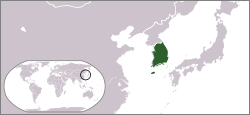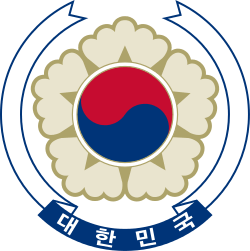Third Republic of South Korea
| Republic of Korea | ||||||||||
| 대한민국 大韓民國 | ||||||||||
| ||||||||||
| ||||||||||
| Anthem Aegukga | ||||||||||
 | ||||||||||
| Capital | Seoul | |||||||||
| Languages | Korean | |||||||||
| Government | Republic under a military dictatorship | |||||||||
| President | ||||||||||
| • | 1962–1979 | Park Chung-hee | ||||||||
| Prime Minister | ||||||||||
| • | 1963–1964 | Choi Tu-son | ||||||||
| • | 1964–1970 | Chung Il-kwon | ||||||||
| • | 1970–1971 | Baek Du-jin | ||||||||
| • | 1971–1972 | Kim Jong-pil | ||||||||
| Legislature | National Assembly | |||||||||
| Historical era | Cold War | |||||||||
| • | Established | 1963 | ||||||||
| • | Yushin Constitution | 1972 | ||||||||
| Currency | South Korean won | |||||||||
| ||||||||||
| Today part of | | |||||||||
Part of a series on the |
||||||||||||||||||||||||||||||||||||||||||||||||||||||||||||||||||
|---|---|---|---|---|---|---|---|---|---|---|---|---|---|---|---|---|---|---|---|---|---|---|---|---|---|---|---|---|---|---|---|---|---|---|---|---|---|---|---|---|---|---|---|---|---|---|---|---|---|---|---|---|---|---|---|---|---|---|---|---|---|---|---|---|---|---|
| History of South Korea | ||||||||||||||||||||||||||||||||||||||||||||||||||||||||||||||||||
 | ||||||||||||||||||||||||||||||||||||||||||||||||||||||||||||||||||
|
||||||||||||||||||||||||||||||||||||||||||||||||||||||||||||||||||
|
| ||||||||||||||||||||||||||||||||||||||||||||||||||||||||||||||||||
The Third Republic of South Korea was the government of South Korea from 1963 to 1972. It was presented as a return to civilian rule after a period of rule by the military junta known as the Supreme Council for National Reconstruction which had overthrown the Second Republic of South Korea in 1961. However, throughout this period the presidency was held by Park Chung-hee, who is the father of Park Geun-hye (current president of South Korea), who had also been an influential member of the junta. He left his military post in order to run as a civilian in the presidential election.
Park ran again in the election of 1967, taking 51.4% of the vote. At the time the presidency was constitutionally limited to two terms, but a constitutional amendment was forced through the National Assembly in 1969 to allow him to seek a third term. He was re-elected in the 1971 presidential election. The leading opposition candidate was Kim Dae-jung, who lost by a narrow margin.
The Third Republic of South Korea was replaced in 1972 by the Fourth Republic of South Korea under the Third Republic of South Korea's president Park Chung-hee.
Economy
The South Korean economy grew rapidly during the Third Republic. The South Korean government used the influx of foreign aid from Japan and the United States to provide loans to export businesses with no interest. It also supported the construction of the POSCO steel mill, which came online early in the Fourth Republic.
On December 6, 1971, Park declared a state of national emergency. On July 4 of the following year, he announced plans for reunification in a joint communique with North Korea. Park declared martial law on October 17, 1972, dissolving the National Assembly. He also announced plans to eliminate the popular election of the president.
Education
This period saw the introduction of several reforms and changes to the educational system. In 1968, the middle-school entrance examinations were abolished, placing all middle schools on an equal footing.
Also in 1968, a Charter of National Education was adopted. This document reflected the government's desire to emphasize nationalism and anti-communism in education. The charter outlined four goals: national revitalization, creating self-reliant individuals, promulgating a new cooperative image of the nation, and supporting anti-communism.
Likewise, the government sought to reduce political activism among college students by increasing academic competition. The government allowed universities and colleges to recruit up to 130% of their graduation quota, so that students would be forced to compete against one another in order to graduate. However, student activism continued at a reduced level despite these measures.
International relations
The Third Republic of South Korea began to take an increasingly prominent role in international relations. Relations with Japan were normalized in an agreement ratified on August 14, 1965. The government continued its close ties with the United States, and continued to receive large amounts of foreign aid. A status of forces agreement was concluded in 1965, clarifying the legal situation of the U.S. forces stationed there. Soon thereafter, South Korea entered the Vietnam War, eventually sending a total of 300,000 soldiers to fight alongside the United States and South Vietnam.
Notes
- ^ Yonhap (2004, p. 271).
- ^ Nahm (1996, p. 423); Yonhap, loc. cit.
- ^ Nahm (1996, p. 424)
- ^ KOIS (2003, p. 336)
- ^ KOIS (2003, p. 336); Yang (1999, p. 757)
- ^ Yang (loc. cit.)
- ^ Cumings (1997, p. 320).
- Cumings (1997, p. 321).
- ^ Nahm (1996, p. 425).
See also
References
- Cumings, Bruce (1997). Korea's place in the sun. New York: W.W. Norton. ISBN 0-393-31681-5.
- Lee, Ki-baek, tr. by E.W. Wagner & E.J. Shultz (1984). A new history of Korea (rev. ed.). Seoul: Ilchogak. ISBN 89-337-0204-0.
- Nahm, Andrew C. (1996). Korea: A history of the Korean people (2nd ed.). Seoul: Hollym. ISBN 1-56591-070-2.
- Yang, Sung Chul (1999). The North and South Korean political systems: A comparative analysis (rev. ed.). Seoul: Hollym. ISBN 1-56591-105-9.
- Yonhap News Agency (2004). Korea Annual 2004. Seoul: Author. ISBN 89-7433-070-9.
Coordinates: 37°35′N 127°0′E / 37.583°N 127.000°E
.svg.png)
.svg.png)